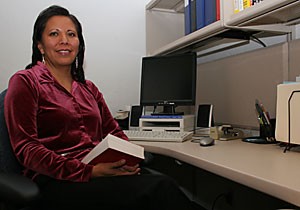As part of a renewed effort to attract more American Indian students to the UA, President Robert Shelton plans to make several visits to tribes across the state.
Shelton’s first visit was to the Pascua Yaqui reservation outside Tucson last week. He said Friday’s visit was “”extraordinarily well-organized”” and he felt very welcome in the time he was there to promote the UA as a viable option for higher education.
“”It’s all about physical presence to demonstrate the sincerity of our intentions,”” Shelton said. “”We seem like a remote location to many people.””
In addition to reaching out to tribal communities, Shelton has appointed Karen Francis-Begay, head of Native American Student Affairs, as his special adviser on American Indian issues.
Francis-Begay said she is excited about her new proximity to UA leadership and can help inform key decision-makers of her concerns, as well as assist in the recruitment effort.
She also said the administration has funded a half-time employee who has been a “”tremendous help”” in her capacity as advisor.
The beginning of tribal outreach this semester is continuing a tradition from the presidency of Henry Koffler in the 1980s, though Francis-Begay said such visits were probably “”fewer and farther between”” in previous years.
Francis-Begay said there are many obstacles to recruiting American Indian students, including their geographic isolation and cultural differences. Though she said the UA works hard to recruit, Francis-Begay said she thinks it would be more worthwhile to aim those efforts at tribal gatherings and other cultural events.
“”College fairs are fine,”” Francis-Begay said. “”But I think they’re really wanting recruiters to get at the real essence of the family.””
Francis-Begay said she has gone with NASA, a group that normally focuses on retention, to the Gathering of Nations in Albuquerque, N.M., and a parade in the Navajo Nation in northern Arizona to recruit students to the UA.
Calling on his background as an experimental scientist, Shelton said actually being on the reservation helped him to learn more about the tribal culture and the students he hopes to attract.
“”You really can’t get a sense of a tribal community until you’ve actually been out there,”” Francis-Begay said. She said many tribal communities are places of economic progress, yet many also face extreme challenges with poverty.
Jennifer Stanley, an equine science junior who grew up in the small town of Kayenta, near Monument Valley, said she always knew she was going to go to college, and the amount of personal attention she received from recruiters was surprising and welcoming.
Ruth Frost, a junior majoring in speech and hearing sciences who grew up in Alaska, said she had a difficult time adjusting to the size of the UA when she first arrived. She said it was also something of a culture shock.
“”It was kind of overwhelming because everybody seems to be so in style,”” Frost said jokingly. “”I came here in just jeans and a T-shirt, and I was like, ‘Oh my gosh, I need to buy some Ugg boots and a mini-skirt.'””
Frost said she had help adjusting through the First Year Scholars program, which aims to make freshman American Indian students feel welcome at the university.
Amanda Tachine, assistant director of NASA, said the program involves about 60 students living in a wing of the Graham-Greenlee Residence Hall in a living-learning community.
She said the living-learning model, which houses and educates students together, mimics American Indian values by fostering a family atmosphere.
“”We’re seeing great success with this program,”” Tachine said.
Tachine said 68 percent of students enrolled in First Year Scholars returned for their sophomore year in 2006, and she hopes the rate will rise this year.
According to data from the Office of Enrollment Management, the overall freshman retention rate for American Indians was 58 percent in the same time period.
Tachine said most American Indian students have the same problems as other students during their first year – finding classrooms and registering online among them – but their problems are compounded by a lack of cultural awareness. For instance, some professors can be unforgiving of students who must observe religious ceremonies.
Shelton said it is important to create an atmosphere where those students succeed because they are the best possible representatives to their communities.
Shelton said he plans to visit the Tohono O’odham and Navajo nations later this semester.









